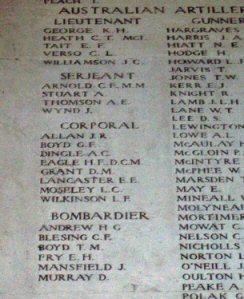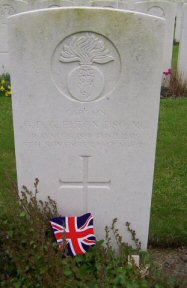![]() MARK GARDINER (with help
from Neil Mackenzie)
MARK GARDINER (with help
from Neil Mackenzie)
![]()
Day Eight - Saturday 26 May
We had planned this day as either an optional rest day, or alternatively as a reserve day in case we had been overoptimistic with our timetable and had missed out any cemeteries on grounds of time or loss of daylight over the previous seven days. However our planning had paid off and we were precisely on schedule.
Given the foreboding weather forecast for Sunday, which promised heavy rain in the afternoon, we decided that we would try to tackle those cemeteries to the North of Ypres on Saturday afternoon, hopefully saving ourselves an hour or two on the Sunday and either beating the rain, or reducing the amount of time we'd spend in the wet.
The day dawned grey and overcast, and we decided to formally visit the Ypres (Menin Gate) Memorial containing the names of more than 54,000 men who have no known grave. Although we had attended the famous Last Post ceremony every night during our stay (indeed, I have never spent an evening in Ypres without attending) this was an opportunity to pay our respects to specific casualties of war in the peaceful early morning; although it is good to see a large number of school parties - mostly, but not always, British - that attend the ceremony. In some ways the sheer bulk and design of the Menin Gate can detract from the impact that the names should inspire, unlike the Thiepval Memorial to the missing on the Somme, whose design draws attention to the names. Most of the panels here have been renovated so that the names can be clearly read, although this is not the case on those panels inside the stairwells. We were paying our respects to: -
Captain Ewen Brodie of 1st Bn. Cameron Highlanders, the 11th Laird of Lethen & Coulmony and son of the Lord Lieutenant of Nairn, who was killed aged 36 in the Battle of Nonne Boschen on 12 November 1914. He had joined his regiment from the militia in 1900 and had served in the Mediterranean, South Africa and China before serving as Adjutant to the territorial Lovat Scouts. He rejoined the Cameron Highlanders as Adjutant on the outbreak of war and was acting Commanding Officer for a period due to officer casualties in September 1914. He was killed whilst commanding a scratch force under General Fitzclarence in repulsing the attack of the Prussian Guard, and has a private memorial in Glencourse Wood. His brother Walter (2nd Bn. Highland Light Infantry) won a VC in the same battle on the previous day.
Private Samuel Evans of 1st Bn. Leinster Regiment who was serving in India when war broke out and was killed on 4 May 1915 aged 24 in the area of Maple Copse. It is possible that he is one of the unknown soldiers of the Leinster Regiment whose headstones can be found in Perth Cemetery (China Wall).
| Corporal Alfred Dingle of 37th Bty. 10th Field Artillery Brigade, 4th Division Australian Imperial Force, who was Neil's great-uncle. Born in 1888 at Newton Ferrers, Devon, he was a ship's purser who enlisted in Sydney in September 1915, and arrived at Marseilles in June 1916 via Egypt. On 14 October 1917 he was in a dugout near the Westhoek-Frezenburg ridge when at breakfast time a shell came over and blew off his left arm. He was buried near a pillbox and the Ypres-Roulers railway and near the Kit & Kat track. The day before he had said: "It's a funny thing all the best men get killed, I suppose it will be my turn next." One comrade described him as:- "One of the finest men in the Battery, a real white man, much liked by his mates" His file is marked "A/Rank not upheld proceedings irregular" but on CWGC records as a Corporal. |  |
We then decided to take a short break from driving, and took a walk from Sanctuary Wood to Railway Wood and the Bellewaarde Ridge, then down to Hooge (visiting the crater) and along the Menin Road to Clapham Junction (where we had a brief roadside lunch) and back to Sanctuary Wood via Hill 62. In the afternoon, under grey skies and the occasional light shower, we made our way north along the canal towards Boezinge.
Our first stop was at
Duhallow A.D.S. Cemetery
at the site of a former medical post,
which was expanded after the Armistice to a large, regular cemetery with
plenty of nice flowers.
 |
Buried here is Captain Gordon Elton DSO MC of Royal Irish Fusiliers, mentioned four times in despatches, and who at the time of his death was General Staff Officer with the 58th Division. Born at Jullunder, India, the son of a colonel, he had attended both Wellington College and the Royal Military College, Sandhurst. He had been commissioned into the 2nd Bn. Royal Irish Fusiliers in 1910, and was serving in India when war was decl;ared, when he resigned his post and was sent to France as orderly officer to G.O.C. 82nd Brigade. His Military Cross was awarded for conspicuous gallantry at St. Eloi on 14-16 March 1915, and was wounded at Ypres on 12 May 1915, before being transferred to Gallipoli as a Brigade Major when he was one of the last men to leave Suvla Bay. Awarded his Distinguished Service Order in June 1917 at the same time as being appointed to the staff of 58th Division, he was killed on 5 November 1917 aged 29 near Poelcapelle by shrapnel whilst escorting two generals. |
Just a short distance along the road, immediately after the junction with the N38, is the well-visited Essex Farm Cemetery, another at the site of a former A.D.S. There were three coaches of schoolchildren there when we arrived, and the grass has been badly worn, with several areas of bare earth around the well-visited graves of young Pte. Strudwick and Pte. Barratt VC. I think the tourist-like atmosphere around here, along with the often strong stench from the canal, that makes this one of my least favourite spots in The Salient. We were visiting: -
Second Lieutenant Harold Butcher of 11th Bn. Rifle Brigade from Purley, Surrey, who had attended Whitgift Grammar School 1901-07. He enlisted in the 1st/5th Bn. (City of London) Rifle Brigade in September 1914, and took part in the action on the Wieltje-St. Julien Road on 13 May 1915 as a member of a small party holding an advanced breastwork which resulted in the award of the first Victoria Cross to a territorial, Serjeant Douglas Belcher. As a result Pte. Butcher was hospitalised with "newasthama" for nearly a month, before attending cadet school in November 1915 before being commission in the 11th Battalion the following month. He died on either 17 (service record) or 18 (CWGC) February 1916 aged 25.
Private John Nuttall of 6th Bn. Somerset Light Infantry, who died on 9 January 1916 and is commemorated on the Accrington War Memorial.
We continued onto Boezinge to visit the one Great War interment in Boezinge Churchyard, Captain Edward Urquhart of 1st Bn. Black Watch (Royal Highlanders), whose headstone is extremely pitted, and his grave dominated by what appears to be a large rhubarb plant! There are more Second World War burials in the shale and stone plot with several shrubs, although they fave at a different angle and are not as heavily weathered. Capt. Urquhart had been educated at Cheltenham and Sandhurst, and was gazetted to the Black Watch in 1897, seeing active service in South Africa before being appointed Assistant Superintendent Gymnasia Irish Command in 1906 (later head of that command 1908). By 1913 he was Inspector of Physical Training for the Army in Northern India, and was at home on sick leave in August 1914, when his request to go to France was turned down of the grounds of the important role he was filling. He trained the Scottish Horse at Perth before being ordered to France in September 1914. On 23 October 1914 the Germans attacked near Pilckem in massed formation, and he was killed instantaneously whilst inspecting a trench recently recaptured from the enemy, aged 37. He was apparently buried next to the late Queen Mother's cousin. Lt. Charles Bowes-Lyon, who grave is now in New Irish Farm Cemetery.
Turning south back towards Ypres is
Talana Farm
Cemetery, set in the middle of fields
and only accessible via a long grass pathway. We were visiting:
-
| Second Lieutenant George Juckes of 6th Bn. Rifle Brigade, a medical student from Horsham who had attended King's School, Canterbury, matriculated at the University of London, and trained at St. Barts Hospital where he passed his first degree in December 1913. He was attached to the 1st Battalion when they launched a successful attack on the area around International Trench (on the other side of the canal) on 8 July 1915; he was killed by a shell, just short of his 21st birthday. |  |
Private Nicholas Butterworth of 1st Bn. East Lancashire Regiment, who is commemorated on the Great Harwood War Memorial, and died on 7 July 1915, possibly from wounds suffered in a small but successful attack made on the previous day.
Bard Cottage Cemetery contains many headstones which have weathered very badly, due to a combination of wind and rain, and pollution from the nearby busy road. We were visiting: -
Private Fredrick Hillier of 1st/2nd Bn. Monmouthshire Regiment, the brother of Albert Hillier who is buried at La Clytte Military Cemetery. He had enlisted in the 2nd Battalion at Crumlin, Monmouthshire in July 1914 and had been promoted to Lance Corporal before losing his stripe for "conduct to the prejudice of good order & military discipline." In July 1916 he was granted 10 days home leave and two months light duties due to shell shock, being then posted to the 1st Battalion, where he was twice punished for being absent from tattoo, before being arrested for desertion in March 1917. The Courts Martial as Oswestry sentenced him to 84 days Field Punishment No.2 and he rejoined the 2nd Battalion in April 1917. He was killed in action on 18 July 1917 aged 22.
Lieutenant Gilbert Bentoit Hone of 'A' Bty. 121st Brigade, Royal Field Artillery from Brockley, South London, who had attended Whitgift Middle School as well as a school at Colwyn Bay and private tuition in Wiesbaden, Germany. A sugar cane planter in Cuba, he had enlisted as a Driver in the Honourable Artillery Company in December 1914, eventually rising to the rank of Acting Serjeant before attending R.F.A. Cadet School in Exeter, being commissioned in the Royal Field Artillery in May 1917. He joined his battery in July 1917 and was killed on 17 August 1917 aged 24 according to CWGC - his service record gives his rank as Second Lieutenant, his date of death as 18 August, and his age as 25!
Private Thomas Brennand of 1st Bn. East Lancashire Regiment, who is commemorated on the Great Harwood War Memorial, and died on 12 June 1915 aged 33.
We took a brief trip over the canal to visit Yorkshire Trench, and also the "Diggers" who were busy in the area of International Trench, where the remains of an unidentified British soldier had been uncovered. Two young English children, who were at the site with their parents, laid a wreath at the Menin gate that night in memory of that soldier.
We had covered 18 miles that day although time was immaterial as we had spent much of the morning trekking around the Hooge area. I believe we dined at the Anker that night.
| Continue reading the Salient Tour Account - DAY 9 |
![]()
 Copyright © Mark Gardiner,
March, 2008
Copyright © Mark Gardiner,
March, 2008
Return to the Contents Section